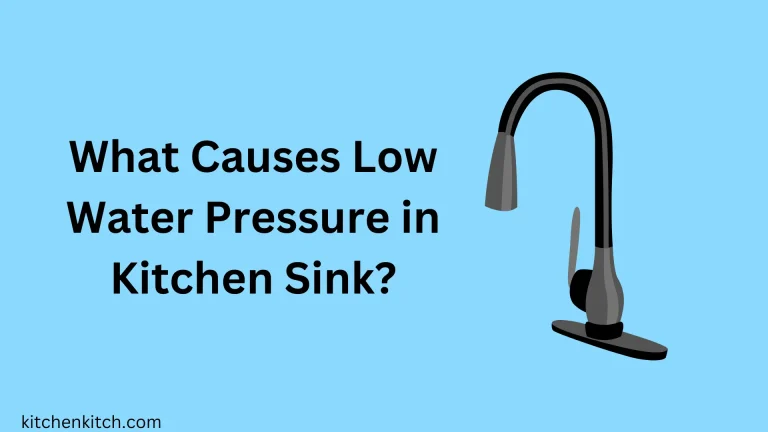Can You Replace a Kitchen Sink Without Replacing the Countertop?
Upgrading your kitchen sink can give your kitchen a fresh new look and make cooking and cleaning easier. If your sink is old and worn out, it’s time for a change. But when you’re thinking about getting a new sink, you might worry about damaging your countertop during the replacement process.
Your kitchen sink is connected to your countertop, so removing it can be tricky. You might wonder if you can replace the sink without having to change the whole countertop. Well, the good news is that in many cases, you can! There are several methods and techniques professionals use to swap out sinks without needing to replace the countertop entirely.
This not only saves you money but also saves you the hassle of redoing your entire kitchen workspace. So, if you’re eyeing a shiny new sink, don’t worry too much about your countertop – there are ways to make the switch without starting from scratch. So, let’s dive into how to replace a kitchen sink without replacing the countertop.
Reasons to Replace a Kitchen Sink
There are several reasons why you might want to replace your kitchen sink:
- Style Update: Over time, your taste and kitchen decor preferences might change. Replacing your sink allows you to choose a style that better fits your current aesthetic preferences.
- Functionality: Older sinks may lack modern features that make cooking and cleaning more convenient, such as deep basins, detachable sprayers, or integrated cutting boards. Upgrading your sink can enhance the functionality of your kitchen.
- Damage or Wear: If your current sink is damaged, rusted, stained, or scratched, it can detract from the overall appearance of your kitchen. Replacing it can restore the visual appeal of your kitchen space.
- Leaks or Plumbing Issues: Persistent leaks or plumbing problems with your current sink may necessitate replacement. A new sink can provide a fresh start and eliminate these issues.
- Hygiene and Cleanliness: Over time, sinks can accumulate bacteria, mold, and unpleasant odors that are difficult to remove. Installing a new sink ensures a clean and hygienic food preparation area.
- Increased Resale Value: If you’re planning to sell your home, a modern and attractive kitchen sink can boost the appeal of your kitchen and potentially increase the resale value of your property.
- Customization: Replacing your sink allows you to customize features such as size, shape, material, and accessories to better suit your cooking and cleaning needs.
Can You Replace a Kitchen Sink Without Replacing the Countertop?
When it comes to swapping out your kitchen sink without touching the countertop, the answer is a definite yes. But hold on a moment! It’s not just a matter of swapping one for the other like trading cards. Your sink and countertop are like buddies in the kitchen, often stuck together with clips and sealant.
Taking out the old sink and putting in a new one involves more than just unscrewing a few bolts. If you try to tackle it solo, you might end up accidentally damaging the countertop. That’s the last thing you want! So, the smart move? Bring in a seasoned plumber. They’ve got the skills and know-how to handle the job without leaving your countertop in a sorry state. Trust me, it’s worth the peace of mind.
Factors to Consider When Replacing a Kitchen Sink
When you’re gearing up to replace your kitchen sink, there are several important factors to keep in mind:
- Sink Size and Configuration: Measure the dimensions of your current sink and the available space in your countertop to ensure that the new sink will fit properly. Consider the configuration of the new sink, such as single basin, double basin, or farmhouse style, and choose one that suits your needs and preferences.
- Countertop Compatibility: Ensure that the new sink is compatible with your existing countertop material. For example, if you have a laminate countertop, an undermount sink may not be suitable without additional support.
- Mounting Options: Decide whether you want an undermount, drop-in, or apron-front sink based on your countertop and aesthetic preferences. Each mounting option has its own installation requirements and visual impact.
- Material and Durability: Choose a sink material that is durable, easy to clean, and complements your kitchen decor. Popular options include stainless steel, cast iron, granite composite, and porcelain.
- Faucet Compatibility: Consider the style and configuration of your existing faucet or plan to install a new one that complements the design of the new sink. Ensure that the faucet is compatible with the number of mounting holes in the sink.
- Plumbing Configuration: Evaluate the plumbing connections and layout to ensure that they align with the new sink’s drain location and configuration. You may need to make adjustments or install new plumbing components during the replacement process.
- Budget and Installation Costs: Set a budget for the sink replacement project and consider additional expenses such as professional installation, plumbing modifications, and accessories like garbage disposals or soap dispensers.
- Warranty and Maintenance: Check the warranty coverage and maintenance requirements for the new sink to ensure long-term satisfaction and durability. Some materials may require special care to prevent scratches, stains, or corrosion.
By considering these factors carefully and planning, you can successfully replace your kitchen sink with a new one that enhances both the functionality and aesthetic appeal of your kitchen space. You should also know how to fix the Cosori Electric Kettle not working.
How to Replace a Kitchen Sink Without Damaging Countertop?
Replacing a kitchen sink without damaging the countertop requires careful planning and execution. Here’s a step-by-step guide to help you tackle the project successfully:
- Gather Your Tools and Materials: Before you begin, make sure you have all the necessary tools and materials on hand. This typically includes a new sink, plumber’s putty, silicone sealant, adjustable wrench, screwdriver, bucket, and towels.
- Turn Off the Water Supply: Locate the shut-off valves under the sink and turn off the hot and cold water supply. If there are no shut-off valves, you may need to turn off the main water supply to your home.
- Disconnect the Plumbing Connections: Use an adjustable wrench to disconnect the water supply lines and the P-trap from the existing sink. Place a bucket under the P-trap to catch any remaining water.
- Remove the Old Sink: Loosen the clips or fasteners holding the sink in place, typically located underneath the countertop. Once the sink is loose, carefully lift it out of the countertop opening and set it aside.
- Clean the Countertop: Thoroughly clean the countertop surface around the sink opening, removing any old caulk or debris. Use a scraper or putty knife to gently scrape away stubborn residue.
- Install the New Sink: Apply a thin bead of the plumber’s putty or silicone sealant around the edge of the sink opening on the countertop. Carefully lower the new sink into place, making sure it is properly aligned and centered.
- Secure the Sink: Use clips or brackets provided with the new sink to secure it to the underside of the countertop. Tighten the fasteners evenly to prevent any gaps between the sink and countertop.
- Reconnect the Plumbing: Reconnect the water supply lines and the P-trap to the new sink, ensuring that all connections are tight and secure. Activate the water source and inspect thoroughly for any signs of leakage.
- Apply Caulk: Use silicone caulk to seal the gap between the sink and the countertop. Run a bead of caulk around the perimeter of the sink, smoothing it with your finger for a neat finish.
- Test the Sink: Turn on the water and test the new sink for leaks and proper drainage. Ensure all components are functioning properly by making any required adjustments.
By following these steps carefully and taking your time, you can successfully replace your kitchen sink without causing any damage to the countertop. If you’re unsure about any step of the process, don’t hesitate to consult a professional plumber for assistance.
Maintenance Tips
Maintaining your kitchen sink and preventing issues can help extend its lifespan and keep it looking and functioning at its best. Here are some maintenance and prevention tips to keep in mind:
- Regular Cleaning: Clean your sink regularly with mild dish soap and warm water to remove dirt, grime, and stains. Refrain from using harsh cleaning agents or abrasive tools that may cause scratches on the surface.
- Avoid Harsh Chemicals: Refrain from using harsh chemicals like bleach or ammonia, as they can damage the sink’s finish and cause discoloration. Opt for gentle, non-abrasive cleaners instead.
- Prevent Scratches: Place a sink mat or protective grid at the bottom of the sink to prevent scratches from pots, pans, and utensils. Avoid cutting directly on the sink surface, as it can leave marks.
- Control Water Temperature: Avoid pouring boiling water directly into a sink made of materials like acrylic or porcelain, as it can cause cracking or damage. Use a sink rack or trivet to protect the sink from hot cookware.
- Fix Leaks Promptly: Address any leaks or drips from faucets or plumbing connections promptly to prevent water damage to the sink and surrounding areas. Tighten loose fittings or replace worn washers as needed.
- Prevent Clogs: Use a sink strainer to catch food particles, hair, and debris and prevent them from clogging the drain. Regularly remove and clean the strainer to maintain proper drainage.
- Maintain Garbage Disposal: If you have a garbage disposal, run it regularly with cold water to prevent odors and keep it functioning smoothly. Avoid putting large or hard items like bones, fruit pits, or grease down the disposal.
- Dry Thoroughly: After each use, dry the sink and faucet fixtures thoroughly with a clean towel to prevent water spots and mineral deposits from forming.
- Seal and Caulk: Check the sealant and caulk around the sink and countertop periodically for signs of wear or damage. Replace any worn or deteriorated caulk to prevent water from seeping underneath the sink.
- Schedule Inspections: Periodically inspect the sink, faucet, and plumbing connections for signs of leaks, corrosion, or damage. Address any issues promptly to prevent them from escalating into larger problems.
Conclusion
In conclusion, replacing a kitchen sink without replacing the countertop is possible with careful planning and the right approach. By following proper installation techniques and maintenance tips, you can upgrade your sink to enhance both the functionality and appearance of your kitchen without causing any damage to the countertop. Remember to seek professional assistance if needed and prioritize regular maintenance to ensure your new sink stays in excellent condition for years to come.








